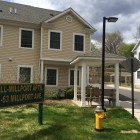Government
Officials: Millport Building Project on Track, Relief from Developer Loophole in Sight
|
The first phase of a large-scale plan to create more public housing at Mill Pond is underway and on track for completion by year’s end, officials say—a widely anticipated project that’s expected to trigger temporary relief for New Canaan from a state law that allows developers to skirt local planning decisions. Under the Affordable Housing Appeals Act, towns where less than 10 percent of the housing stock qualifies as “affordable” by the state’s definition (New Canaan’s is at about 2.4 percent), developers may bypass Planning & Zoning by designating a percentage of units within proposed new structures as affordable. Ten percent is a rigorous standard that towns such as New Canaan are unlikely to meet, mostly because the state in calculating “affordable” lumps the town into the sprawling geography of the “Norwalk-Stamford Metropolitan area.”
Yet there’s a way to get relief under a provision (a complicated provision) in the state law. Under the provision, types of housing are assigned a certain number of points based on variables such as how much they cost (in mortgage payments or rent) and whom they serve (seniors or families). If a town amasses enough “housing unit equivalent” points, it can earn a four-year exemption.


